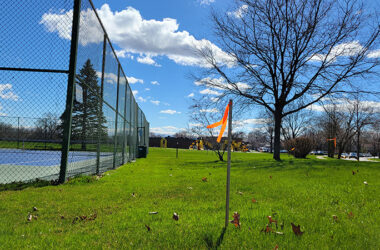
Angela Latham sit in an
old school desk. (Photos by
Marilyn Thomas/
H-F Chronicle)
Willow School second graders can tell you about James Hart and the Homewood Brick Yard, the Gottschalk House and when Homewood became a village.
It’s all part of the social studies curriculum teachers use to introduce students to history.
But the 7-year-olds got lots of surprises when they toured the 125-year-old Dorband-Howe House in May. They stood in a kitchen that had been warmed by a coal-heated iron stove, learned about a summer kitchen that doubled as a clothes drying space in winter, and saw the implement that gave settlers toast cooked in an oven.

off a more than 100-year-
old masher, the first food
processor.
The Dorband-Howe House, maintained by the Homewood Historical Society, was built in 1891 as a sturdy brick structure, but it had no running water or electricity, and no indoor bathroom.
A walk from Willow School to the two-story house at 2035 W. 183rd St., has become an annual event. Teacher Amanda Crossley said she inherited the Homewood history project when she started teaching second grade 11 years ago, but she remembered the field trip from her days as a student at Willow School.

watches as Lesley Contreras
works to make the name
Homewood appear from
the Homewood-stamped
brick.
The class splits into two groups so that volunteers Magda Hepokoski and Elaine Egdorf can share their knowledge of how Homewood’s settlers lived: How boys had to pump pails of water from the well for use in the kitchen and for the laundry, and how girls used a washboard to scrub clothes clean, then put them through a ringer to squeeze the water out and hang them on the clothes line to dry.
“Children were the labor saving devices” of those times, Egdorf told them.
Hepokoski stood in the kitchen pointing out jars for canning fruits and vegetables, oil lamps that provided light, scales used to weigh the hens’ eggs for sale, and a churn to make butter. Several of the students handled a vegetable and fruit masher implement that she identified as “the first food processor.”

member Elaine Egdorf
demonstrates how a bar of
soap and scrub board were
used to wash clothes.
Egdorf showed the class the old Sears catalog that several Homewood families used to specially order a home – in pieces – that was delivered by U.S. mail.
She told them about the old Washington Park Racetrack along Halsted Street. A horse race there was the first televised sporting event putting Homewood on the national map.
“They loved seeing the way kids dressed back then and learning about how many chores children had to do,” the teacher said. “The specific artifacts that were their favorites were: the oil lamp, the train bell, the toaster, the woman’s bathing suit and the picture viewer.”
Crossley said the children’s favorite part of the visit was finding the bricks stamped “Homewood” and doing brick rubbings. She carried the papers back to school and placed the rubbings in their Homewood history folders.


